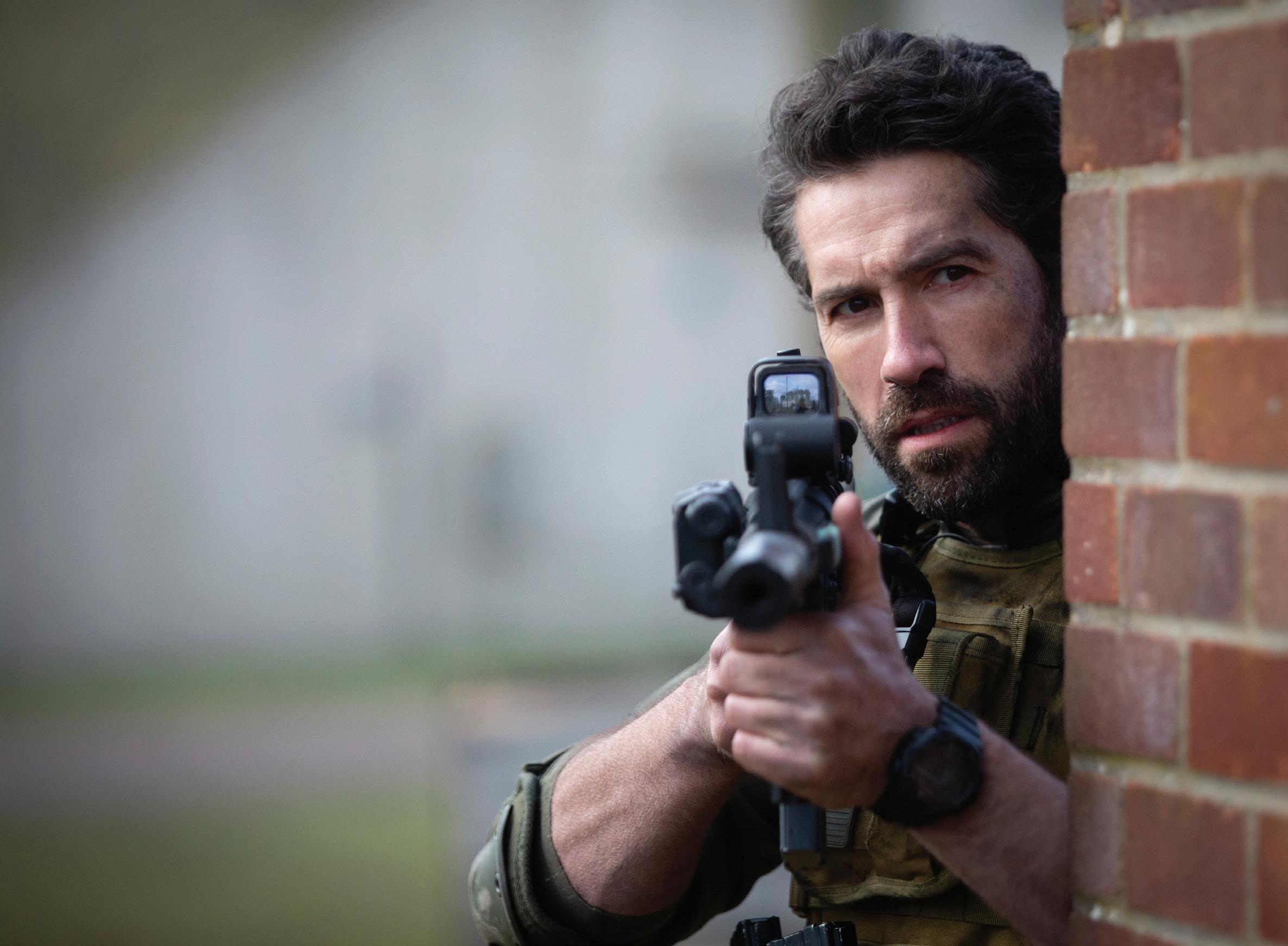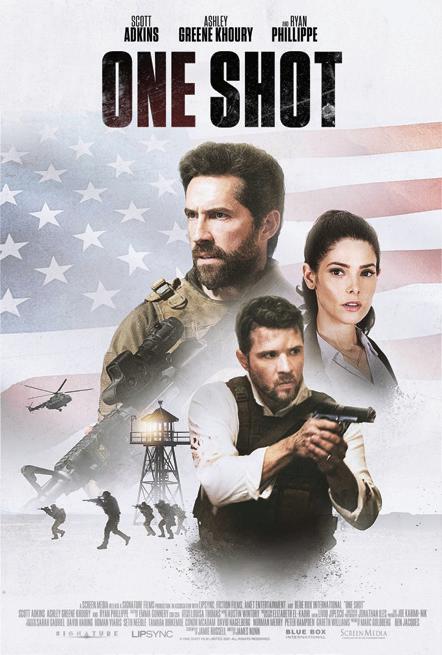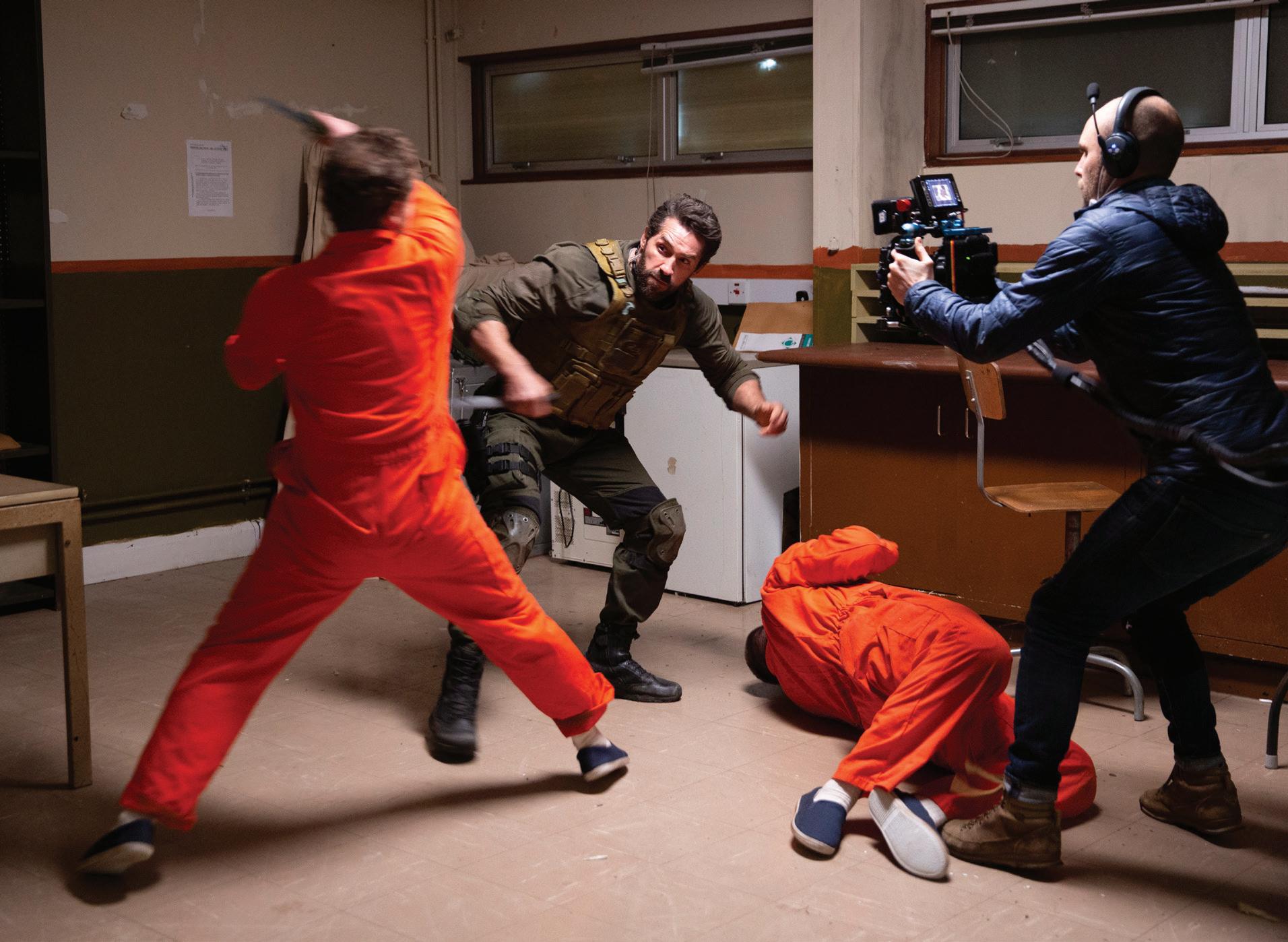
by AMERIFORCE MEDIA, LLC NOVEMBER / DECEMBER 2021 TOP FRANCHISES FOR VETERANS UNAPOLOGETICALLY AMERICAN HELMETS TO HARDHATS PILOT HITS MILESTONE THANK YOU, VETERANS USAA means United Services Automobile Association and its affiliates. © 2021 USAA. 273852 - 1121 USAA.COM/VETERANSDAY On Veterans Day, we celebrate the men and women who took the oath to serve the nation. Today, and every day, we thank you for answering the call to serve.

2 | www.reservenationalguard.com Insured by NCUA. Your Service Inspires Ours Everything we do is inspired by the military service and sacrifice of our members. We’re grateful for our 1.5 million+ veteran members and their commitment to our country—and we’re proud to support them with special o ers, financial resources and award-winning service. Learn more at navyfederal.org/veterans
What does it take to be the best — in your professional career, personal fitness, or whatever milestone you are looking to achieve? Your definition may look different than mine, which doesn’t matter because success and achievement aren't cookie cutter molds. For 1st Lt. Amber English, a soldier who won gold in Tokyo, her intent for the Summer Olympics was to not let anyone outwork her.

We spoke at this year’s Association of the United States Army event about competing on the world stage and how to prepare to go up against the best in their field. (She even let me hold the gold medal.) She and fellow Olympian Staff Sgt. Sandra Uptagrafft agree that once you get the skill part of your craft down pat — whether that be a sport, MOS and so on — the mental portion is even more important.

The end of the year is always a good time for introspection. Is there something you wanted to achieve that you fell short on? With new runway in 2022 to work with, what will you do differently?
ABOUT THE COVER




www.reservenationalguard.com | 3 LETTER FROM THE EDITOR contributors
Chris Adams
Crystal Kupper Andrea Downing Peck
Tim Kennedy is a Special Forces master sergeant, sniper and entrepreneur who previously competed in professional mixed martial arts events.
@ReserveGuardMag
Photo by Douglas Ladd of Take Your Shot Productions LLC
@reservenationalguard @RNGmagazine
Rear Adm. Brian E. Luther, USN, (Ret.)
Amy Pottinger Elizabeth Aslakson
1st Lt. Amber English (left) with Staff Sgt. Sandra Uptagrafft.
by Andrea Downing Peck

 by Kari Williams
by Chris Adams
by Kari Williams
by Chris Adams
 by Kari Williams
by Kari Williams
Content Editor: Melissa Stewart
Amy Pottinger
4 | www.reservenationalguard.com AmeriForce Media, LLC 205 N. College Avenue, Suite 450 Bloomington, IN 47404 https://ameriforcemedia.com Printed in the United States. ©2021 AmeriForce Media, LLC Reserve & National Guard Magazine is published six times a year for reservists and members of the National Guard. Copies are available through participating Reserve and National Guard training centers at no cost. Unit distribution requests can be made online at: https://reservenationalguard.com/print-magazines/ Individuals can order a free digital edition of this guide at: https://reservenationalguard.com/digital-magazines/ Editorial comments can be emailed to: managing.editor@ameriforcemedia.com Reserve & National Guard by AmeriForce Media is published by AmeriForce Media, LLC, Bloomington, Ind., a private company. Information and advertisements in this publication do not constitute endorsement by any branch of the military or the Department of Defense. No part of this publication may be copied without the express written permission of the publisher. AmeriForce Media, LLC, the publisher, and publisher’s agents make no endorsement of any advertised services or products and none should be inferred.
President and Publisher: Todd Taranto
Managing Editor: Bianca Strzalkowski
Yost
Look Business Solutions ADVERTISING
CALL 703-337-8100 EDITORIAL AND PRODUCTION
President, Sales: Julie Miller Julie.Miller@AmeriForceMedia.com
Associate Editors: Kari Williams and Teal
Design: Open
PLEASE
Vice
Shot,’
Adkins’ latest action flick, centers
6 Marine captures global adventures one post at a time 20
‘One
Scott
on military realism
Pilot credits ‘timing and luck’ for achieving 7,000-hour milestone 24
day recipes 26
Game
10 NOVEMBER - DECEMBER 2021 ISSUE Contents
by
Who is Tim Kennedy?















































Claudia Ramirez Military Spouse “GEICO has made our transitions easier and given us less to worry about. They’ve always been there to help us.” Get your discount today. geico.com | 1-800-MILITARY | Local Office Military Discount for Heroes Like You Some discounts, coverages, payment plans and features are not available in all states, in all GEICO companies, or in all situations. GEICO is a registered service mark of Government Employees Insurance Company, Washington, DC 20076; a Berkshire Hathaway Inc. subsidiary. © 2020 GEICO
‘One Shot,’ Scott Adkins’ latest action flick, centers on military realism
 BY KARI WILLIAMS
BY KARI WILLIAMS
Scott Adkins has donned military uniforms for several movie roles in the past and has put his martial arts skills to use on as many occasions, but for his latest flick, “One Shot,” it’s all about realism.

“Our movie is so plot-driven, [you’re] so much immediately in this situation for my character, it’s all about the mission for him,” Adkins said of Lt. Jake Harris, a Navy SEAL who leads his team alongside a junior CIA analyst (played by Ashley Greene) to prevent a terrorist attack on Washington, D.C.
As its name suggests, the film – also starring Ryan Phillipe –was made “in one continuous take,” showing 90 minutes in one character’s life, Adkins said. Director James Nunn and Adkins created the concept for the Netflix film, which is available for streaming on Nov. 5.
‘One Shot’ is ‘all about the mission’
The film is so plot-driven, according to Adkins, that the audience is “immediately in this
situation” with his character.
“I felt like it’s all about the mission for him,” Adkins said. “That’s what he’s all about, so I could just focus on what’s the mission and how do we get out of this situation.”
As for the military community, they’ll enjoy the “close-quarter combat” in the film, Adkins said.
“We start off with guns and we get to a place where the bullets run out, and it gets a little more up close and personal,” Adkins said. “You know, I’ve done a [lot] of crazy martial arts films, but we wanted to stick with the tone of the movie, which was realistic.”
To keep that realism alive, Tom Leigh, a Royal Marines Commando veteran, was brought in as a military adviser. Leigh spent seven years (2008-15)
serving, including time with the U.K. and U.S. special forces in Afghanistan.
How much time Leigh has for a given project determines how
much he is able to work with the actors on specific areas. For “One Shot,” time was limited, so his main focus was weapon-handling and ensuring confidence among the actors.
6 | www.reservenationalguard.com OFF DUTY
Scott Adkins plays Lt. Jake Harris, a Navy SEAL who leads his team alongside a junior CIA analyst (played by Ashley Greene) to prevent a terrorist attack on Washington, D.C., in “One Shot.” Photo courtesy of Screen Media.
Scott Adkins stars in "One Shot," which is available in theaters and on demand beginning Friday, Nov. 5, 2021.
“It’s massively important for a film,” Leigh said. “We can expand from there to how they hold their body, how they move, how they talk.”
Adkins and Ryan Phillipe were “brilliant,” according to Leigh, because both had prior experience with other film roles.
“Everyone put in 110%, which is amazing,” Leigh said. “In fact, Ashley Greene, I must say, I would say, was the most dangerous person in terms of how good she was with those weapons. She’s a real natural for it.”

Following working with the actors on proper weapon-

handling, Leigh turned their focus to movement.
“There’s some distinctions between the way the SEALs move and the way they handle their weapons, the way the Marines move and handle their weapons and the way the insurgents move and handle their weapons,” Leigh said. “Everyone’s got slight different things to tell them apart, so we really worked hard on that.”
Showing a ‘chaotic feel of battle’
The “minor things,” according to Leigh, are what the military community will pick up on but are “rarely” seen in Hollywood depictions of that community.
“You’ll see someone handling a weapon and think that’s cool and then they’ll watch and see actually he’s doing a brass check on his weapon,” Leigh said. “He’s pulling out his magazine and checking how many he has left and putting it back in.”
The SEAL team, Leigh said, is no exception to those details, with the actors checking corners before clearing a room and clearing doorways.
“Because it’s one shot and you’re always in the action, everything’s moving really fast, it really does replicate that chaoticness and chaotic feel of battle,” Leigh said.

www.reservenationalguard.com | 7
“One Shot” is available in theaters and on demand beginning Nov. 5.
Scott Adkins (left) works with Tom Leigh, a military advisor and former Royal Marine Commando, on the set of "One Shot." Photo courtesy of Screen Media.
JARRARD:
COMMUNICATION KEY FOR INTEROPERABILITY
 BY BIANCA STRZALKOWSKI
BY BIANCA STRZALKOWSKI
The deputy commanding general for Army National Guard in U.S. Army Europe and Africa said he is focused on “forward progress” with allies and partners as relationships “start gaining momentum again.”

Maj. Gen. Joe Jarrard stepped into his current role after initially gaining international experience as adjutant general of Georgia National Guard. Under his leadership, the unit expanded its partnerships to include Argentina — in addition to a 24-year relationship with the country of Georgia. He says that work with the National Guard Bureau’s State Partnership Program helped him to understand “the role we played underneath EUCOM’s strategic umbrella.”
“I understand that relationship between the states and their country partners and so it just helps me be able to facilitate those relationships — now, COVID put a stop on all of that for about a year-and-a-half but … adjutant generals started making their first trips this summer to reignite those relationships,” he said. “It’s really nice for them to be back on the continents to start gaining momentum again with that program because it really is a game changer.”
The two commands, U.S. Army Europe and U.S. Army Africa, consolidated in 2020. As part of the rotational deployment of forces, personnel from various units work with international counterparts through ongoing training events, like Atlantic Resolve and DEFENDER Europe. Jarrard says interoperability is key.
“Interoperability is one of the keys that we focus on in all that we do because we have to be able to communicate,” he said. “Now, I think interoperability has a lot of different levels to it. At the high end we’ve got our systems and radios and communication suites that have to be able to talk to each other — and we work that throughout all of our exercises. … At the lower level, soldier to soldier and the language piece, that’s why we do exercises; that’s why we work with all of our international partners as often as we can.”
Since assuming his duties in 2019, Jarrard
said he has been “proud” of how U.S. forces engage with international peers — something he attributes to “good culture, good leadership.”
Jarrard’s long career has included its own transitions, starting with a commissioning in the U.S. Army in 1988. He served on active duty for 20 years, according to his official biography, with operational deployments in support of Operation Iraqi Freedom in 2003 and 2005. His advice for soldiers and airmen looking for upward trajectory in the military is simple: know your job and be a lifelong learner.
“They need to know their job. It’s not about waking up and existing and just getting by; they need to be experts at what they do. And as they become experts at what they do, one, they’re more proficient at it, two, they can be better leaders because they understand what their unit is supposed to do and the role they fit into with that mission,” Jarrard said. “As they gain that experience, and mature and grow in uniform, they can understand the bigger picture as well.”
8 | www.reservenationalguard.com LEADERSHIP CORNER









º––92731 (1/21), 92558 (7/21), 93347 (11/21) Copyright 2021 Mercer LLC. All rights reserved. MOAA Group Leader Term Life Insurance You have plans for your family’s future, but sometimes the future has its own plan. That’s why the Military O cers Association of America (MOAA) o ers its members the Leader Term Life Insurance Plan with coverage amounts up to $1 million, depending on age, to protect your family against life’s unexpected. And you are covered anywhere in the world even if ying in a military aircraft. This plan o ers many bene ts, is available to members and spouses† and is o ered at a ordable group rates. † Spouse includes domestic partner in the state of Oregon. Group Term Life Insurance is underwritten by ReliaStar Life Insurance Company, Minneapolis, MN. This coverage may have exclusions, limitations and reductions in benefits. This plan may not be available in all states. Please contact the plan administrator for details. The group policy is sitused in Virginia and is governed by its laws. This is a paid endorsement. MOAA receives a fee from the insurance broker and/or insurer for its endorsement of this plan. Policy Form #LP00GP. Program Administered by Mercer Health & Benefi ts Administration LLC AR Insurance License #100102691 I CA Insurance License #0G39709 In CA d/b/a Mercer Health & Benefits Insurance Services LLC For more information about the MOAA Group Leader Term Life Insurance Plan, visit www.moaainsurance.com or call 1-800-247-2192. Not a member of MOAA? Join today at www.moaa.org Standing with you at every stage.

10 | www.reservenationalguard.com UNAPOLOGETICALLY AMERICAN
BY CHRIS ADAMS
The Green Beret intraining was smart. After deftly collecting intel, he buried MREs before the evasion phase at SERE training.
Instead of scrambling for food in the remote North Carolina terrain, he could figure out how to engineer a hammock while others wrestled with thoughts of hunger. There were 11 Special Forces trainees and an airman.
The plan seemed epic. There was enough food for all. Heck, they could all construct hammocks. But the airman tossed a spanner in the works. He wanted no part of the MREs, questioning their origin.
“How did they get buried here?”
The Green Beret trainee replied, “I don’t know, somebody buried them. Would you like some food? There’s 2,000 calories here.”
The airman declined. “No, this is cheating.”
The trainee disagreed, “It’s not cheating. This is us eating. This is surviving.”
And then came the concentration camp phase.
I rolled up to Tim Kennedy’s well-appointed sprawling home in Cedar Park — one of many affluent suburbs north of Austin, Texas — during a vision-impaired rainstorm. The autogate allowed me to pass through. I had a mask around my neck just in case, but Kennedy and his young children greeted me at the door and informed me a mask policy wasn’t in effect at the Kennedy home.
Dressed in workout shorts, a People’s Republic of Pineland T-shirt (a fictitious country used for staged invasions in Green Beret training) and a baseball cap turned backward, he appeared ready for come-what-may. We partook in some sparkling water from a can and dove into the interview.
Surviving life while embracing it could be a mantra for this Green Beret and once-topranked MMA Strikeforce and UFC fighter. His collection of experiences sounds like a towering love song to life.

Kennedy is currently assigned to the Texas National Guard’s Special Operations Detachment, but his armed forces foray began nearly two decades ago in the wake of 9/11.
“I enlisted while I was in grad school after 9/11,” he said, “and then went to Fort Benning for basic and then went to infantry school … and then it was like, Benning, Bragg, deployment, Bragg, Benning, deployment. Just going to different schools."
Kennedy has been to South America, the Caribbean — JSATs (Joint Security Assistance Training) and FIDs (Foreign Internal Defense) — Afghanistan and Iraq. The master sergeant has logged more than 20 deployments, from advising and counterhuman-trafficking operations to counter-drug and counterpoaching missions. He has also combated piracy in Africa and performed human intelligence work in Eastern Europe.
But the essence of the man, and his zest for life, were put to the test during one particular deployment.
Somewhere in a valley in Afghanistan, Kennedy faced death. The fighter found himself in a treacherous and vulnerable firefight with the Taliban.
But it wasn’t a high or low point for Kennedy. Rather, he said, it was a transitional one.
He had been a part of numerous task forces. In a prior combat deployment, his ranger regiment was assigned to a Delta task force that killed the al-Qaeda terrorist Abu Musab al-Zarqawi. He had seen the terrorist’s indignation expressed through violence many times.
“There’s never a fair fight,” he said. “We just murdered everyone. When you’re at that level, there’s nobody on the planet that can compete or hang with us.”
Thankfully, he didn’t become Walter Kurtz.
“It was a different thing when a year and a half later, I go to Afghanistan, and I’m by myself with a Czech special forces unit, and we’re getting ambushed in a valley,” said Kennedy, who was a United States Army Special Operations Command liaison to the Czech special forces and helped establish them in the infamous Firebase Anaconda.
“Firebase Anaconda no longer exists because it was overrun
by the Taliban so many times, and they ultimately took it … and I was escorting the Czech into this firebase when we were ambushed,” he said.
The ambush initiated a neardeath, days-long gunfight with waves of surging Taliban fighters.
“For the first time, I kinda put on big-boy pants as a Special Forces guy,” he said. “Everything else up to that point was like, ‘America,’ and this was fighting. This was like looking out over bodies and like, ‘Where can I find some ammo because we’re out of ammo.’ It’s a different thing … It was definitely a culminating moment.”
Throughout active duty, Kennedy also maintained a successful professional MMA career. But the Army’s tepid response to his twopronged career and prowess in the octagon resulted in an ultimatum.
“So they went the route of you kinda have to decide between the two,” Kennedy said. “And so I went to the National Guard to SF (Special Forces)… and then came to Texas.”
The Army’s dictate didn’t suit the former top-ranked middleweight. He wanted to consume the whole cake, call the shots. His insistence seems more of a necessity than hollow arrogance. A need to feed a passionate and convicted machine to ensure it’s operating
www.reservenationalguard.com | 11
In 2021, Tim Kennedy is more than a successful finger-in-the-pie entrepreneur and entertaining guest on the Joe Rogan Experience.

He recently was in Afghanistan as part of an NGO rescuing stranded Afghans who have special immigrant visas, or SIVs. Kennedy drove busloads of people to the Kabul airport. Social media threw some shade on his efforts though, questioning his methods and the validity of his presence.
“The talented group I was attached to as a volunteer was listed in the command center as a supporting element. We were part of the team. If that were not the case, I would not have been allowed to assist and support in any actions that involved going outside the wire,” wrote Kennedy in an Instagram post
The Army is still in his blood. Love for America and his fellow human beings and life seems to still be driving him. His belief in freedom is his fuel.
“If you’re not supporting somebody’s right — their constitutional right — how are you going to feel when they don’t support your constitutional right?”
Kennedy said. “That’s the idea of freedom, is that you’re free … I want them to be able to do things that make my blood boil. That angers me so much, and philosophically, emotionally, spiritually, I’m the antithesis of that. I look at that and I’m like, ’That’s wrong in every way, shape and form. But man, it’s cool that you can do that.’”
at full capacity. The Army’s options weren’t an option.
“Are those my options? I want to create my own options,” he said.
When Kennedy departed U.S. Army Special Forces to pursue fighting, the Army ironically saw the benefit of sponsorship, paying him six figures to wear “Go Army,” he said.
“This is the irony of bureaucracy,” he said, “and this is the irony of large organizations, and we have been the worst at this … We forget about the individual, but we’re a collective of the individual.”
Preparation for fighting and warfare has, “a lot of bleed-over in the practices,” according to Kennedy, such as regimentation, discipline, organization and strategizing. These characteristics certainly helped Kennedy achieve an 18-6 fight record in Strikeforce and UFC.
“The skill development leading into the PMT (pre-mission train up), we’re working on

breaching, I’m working on my sniper skill, or I’m working on my free fall … When you look at the fight thing, you have my fight camp, pre-fight camp. I’m working on my Brazilian jiu jitsu. I’m working on my wrestling … I’m building the individual capabilities … and then we go and execute in the arena,” Kennedy said.
And of course, both require battle. But that’s where commonality departs.
“Walking into the octagon compared to throwing a flash-bang through a window and shooting someone in the face, those are pretty different things,” Kennedy said.
On Sept. 27, 2014, in Las Vegas, Kennedy didn’t toss a flash-bang but fought his most famous – and infamous – bout. Some might argue it was the lowest point of a career or a blessing in disguise.
In a fight now dubbed “Stoolgate,” Kennedy squared off against Cuban Yoel Romero. Romero was a UFC rising star who competed under the appellation, “Soldier of God.” He had won a silver medal in freestyle wrestling at the 2000 Sydney Olympics.
“I fought for two world titles … and I lost two world titles,” Kennedy said. “When Michael Bisping was the UFC middleweight champion, Yoel Romero and I were the two contenders. So we fought a contender fight — and I already fought Michael Bisbing and decimated Michael Bisbing — I beat Yoel Romero, I’m fighting for the UFC middleweight title.”
The fight was close for two rounds. Then controversy ensued. Romero didn’t come out for the third round, as Vaseline was applied to a cut and removed per the referee’s instruction. Kennedy had severely stunned Romero at the end of the preceding round. The Cuban fighter ultimately rested for 30 seconds longer on a stool.
12 | www.reservenationalguard.com
ALL IMAGERY BY DOUGLAS LADD. UNAPOLOGETICALLY AMERICAN
“He doesn’t answer the bell, and I get destroyed in the third round,” Kennedy said.
UFC President Dana White told Bleacher Report in 2014, “That’s an old dirty trick.”
“The thing that throws a kink in the thing is that it was our guy that put the Vaseline on… They called his guy in to wipe the Vaseline off,” White said. “He didn’t understand what they were saying. It’s very unfortunate.”
Though the Romero fight wasn’t exactly a highlight for Kennedy, he said a fighter is one punch from drinking out of a straw.
“That’s a pretty low moment,” he said. “But also probably the best thing because had I won that, then I would have fought Michael Bisping, become champion and then I would have fought another three to four years… I’m not an anomaly, but compared to most fighters that fought 17 years, from concussions and TBIs, CTE (chronic traumatic encephalopathy), it’s a different thing talking to them than it is talking to me.”
Kennedy retired from the sport in January 2017 and reenlisted later that year as a Green Beret. He is now a serial entrepreneur involved in 24 entities and the owner of 11 multimillion dollar companies.
And he is solidifying the businesses for longevity instead of building and then exiting.
“These are businesses that have headquarters, that have physical brick-and-mortar retail spaces. All of those things have legs now that will be generational. I think I’m going to continue to shore up the businesses I have and not build any more than what I currently am doing … I launched five businesses this year,” he said.
He also has a book, “About Failure,” slated for release in 2022.
“The overarch is this too-dumb-to-quit mentality,” Kennedy said. “Stories in that book are so really unbelievable.”
I believe it.
And what did Kennedy learn back at SERE training where he had stashed a trove of MREs?

“So you’re incentivized to not get caught during the evasion week because the earlier you get caught, the longer you’re in the concentration camp,” he said. “Most people end up in the resistance phase starved to
death because they haven’t eaten in 10 days.”
He said the 11 Special Forces soldiers helped him secure the sustenance, but the airman was the lone wolf who stood his ground.
“All of us kind of respected him for that … we all supported him in that,” Kennedy said. “But then when we got to indoc … as you’re being processed into concentration camps, you have a black bag on your head, and they tear the black bag off, and they start hitting you. Like, ‘What’s your name? What’s your social security number, or what is your unit? What do you do?’”
He said they were instructed to use proper techniques to deflect any form of betrayal. In SF vernacular, it’s referred to as “staying in your circle.”
“And his bag came off, and he just started screaming, ‘They buried food! They cheated!’ And all of us were in a line, and we could hear his voice like a bell in the middle of the night ringing as he’s screaming, ‘They cheated, they cheated, they cheated! They had food buried.’ And they immediately separated all of us.”
Kennedy said this was the first time a SERE training interrogation went from role-playing
to real — as far as he knows.
“If the 11 of us break, I’m kicked out of Special Forces. I don’t get my green beret. I never go to a Special Forces ODA (Operational Detachment Alpha). And from that moment on … for the duration of our time in the concentration camp they were legitimately interrogating all of us.”
No one broke, but the airman was dismissed from the school.
“He was lying. He had 11 people that were disagreeing with him,” Kennedy said.
In this time of COVID-19, Kennedy holds God, family, and country most sacred. God is the how and why of what Kennedy does. But at the end of a workout or a mission, know this – Kennedy selects his song, his dance.
“I’m gonna go and take what you’re giving me, and I’m gonna, like, smash that against the wall. I’m gonna go do my own thing … That’s just how I roll,” he said.
www.reservenationalguard.com | 13
Visit www.timkennedymma.com to learn more about Tim Kennedy’s companies and upcoming book launch.
Sailor scores with dual career
BY CRYSTAL KUPPER
Navy reservist Joe Greenspan’s all-American childhood included playing hockey in the driveway with his three siblings and swimming during the humid summers of New Jersey. But it was soccer, with its fast pace and uninterrupted action, that he relished – from preschool to the majors.
“The more I played soccer, the more I fell in love with the game,” said Greenspan, a current public affairs officer in San Diego and former USL Championship soccer player. Both of Greenspan’s grandfathers served in the military, while a great uncle graduated from West Point. So a career in public service made sense. But for Greenspan, so did soccer.
Academy man
Greenspan struggled with injuries in high school, including a broken foot and torn ACL. He figured they would keep him off the radar of major recruiting lists and certainly off the roster of any professional team.
Then the Naval Academy came calling.

“I was looking to get the best education while playing soccer in college,” he said. “When you look at the person you can become at the Naval Academy, it really was a no-brainer.”
Greenspan played varsity soccer for the Midshipmen, graduating in 2015. He knew he wanted to try for a career in professional athletics and the Navy at the same time, despite the improbability.
“My brothers and sister had to give up a lot for me to be able to do my thing, and my parents spent a lot of time on soccer travel,” the 29-year-old said. “So if I had the opportunity to play at a high level while making them proud through the military, I wanted to do that. Luckily the Navy said I could do both.”
Greenspan kicked off his Navy career in May 2015 as a Surface Warfare Officer, eventually serving aboard the USS Sampson. Just one month later, the soccer defender was the 26th overall selection by the Colorado Rapids in the 2015 Major League Soccer Superdraft. He served a year of active duty before switching to the reserves so he could fully pursue soccer.
“It was definitely a bit of culture shock, being on a ship for seven months with no soccer,”

CAREER 14 | www.reservenationalguard.com
Greenspan said. “Then, in the [Navy] Reserve, I had a smile on my face, because this organization, government and country made it to where I could fulfill my dream and play pro sports, too.”
Defender forever
Greenspan was traded to MLS expansion club Minnesota United after the 2016 season. From there, he went to the Pittsburgh Riverhounds, playing his best soccer. He earned a spot on the 2019 USL Championship All-League 1st Team and was the 2019 USL Championship Defender of the Year. Greenspan finished out his career for the San Diego Loyal, where soccer star Landon Donavan called him “the best defender in the league.”
Since 1879, Navy Mutual has been trusted by military families to be there during their times of greatest need. Our nation counts on the military. You can count on us. Our products feature no active duty service restrictions and we provide unmatched beneficiary services to ensure you have only one call to make.

Unfortunately, injuries felled him once more. Greenspan tore his hip flexor twice and suffered multiple concussions, leading him to exit professional soccer in 2020. He plans to coach his future children, like his father did for him, and he still watches his friends play in adult leagues in San Diego.

“I have to resist the urge to play myself,” he laughed.
In addition to serving in Public Affairs, Greenspan currently works for a digital
performance marketing agency. It’s a totally different experience waking up and not physically hurting, he said.
So much of Greenspan’s success, he believes, can be traced back to the Navy.
“I really put myself into playing soccer and my job as a naval officer while doing them well, when they’re both very demanding,” he said. “For both soccer and the military, you understand you’re a part of something bigger than yourself.
www.reservenationalguard.com | 15 Helping you protect what matters most.
Military. Life. Insurance. Visit NavyMutual.org
“Sometimes, things being unconventional end up working out quite well.”
Read more about Navy Mutual on page 22 >
TOP
FRANCHISES
FOR VETERANS
BY CRYSTAL KUPPER
Roughly 14% of franchise business owners are former military, according to VetFran, a 20-year-old program from the International Franchise Organization that encourages relationships between veterans and franchised businesses. One of those veterans is Floyd Beck, who served 10 years in the Air Force. He and his wife are franchise owners of Assist-2-Sell Your Choice Realty in Mountain Home, Idaho. Before that, they owned a franchised coffee and juice shop.
Franchising allows owners to take advantage of brand recognition, he said.
“A good franchise has a proven model of success that they will teach you to do and will ensure you stay on track with,” he said.
Franchising also offers those who are still serving, like members of the National Guard or reserves, the chance to run their own business while still being part of a structured, supportive team.
Several industries have franchise opportunities, meaning veterans can choose the type that works best for them. Nationwide, hundreds offer veterans discounts and other special supports.

16 | www.reservenationalguard.com ENTREPRENEUR
Check out these franchises from a variety of industries that aim to attract former military:
1. JDog Carpet Cleaning and Floor Care — The owner is a former soldier and National Guardsman who only offers franchise opportunities to veterans. So far, the company has more than 1,000 franchisees.
2. British Swim School — This 36-year-old swim school uses existing pool spaces in local communities and offers a 20% discount off the initial franchise fee for honorably discharged veterans.
3. Painting with a Twist — Ranked the top “paint-and-sip” franchise by Entrepreneur magazine in 2018, Painting with a Twist not only offers a 20% veteran discount for franchise fees, but a unique painting studio experience for consumers.
4. Pet Butler — The pet-waste removal service gives veterans $4,000 in extra marketing credits.
5. Ice House America — A pioneer in automated ice vending technology that sells bulk and bagged ice, as well as purified water, Ice House America waives half of startup fees, as well as the first year of royalties, for former military.
6. Kilwins Chocolate — Veterans can satisfy their sweet tooth and save some money with $10,000 off the franchise fee.
7. Granite + TREND Transformations — A kitchen and bath remodeling company that knocks $7,500 off the initial franchise fee.
8. Burn Boot Camp — A female-focused fitness center offers a 15% reduction in initial franchise fees for veterans.
9. WSI Digital — WSI Digital gives veterans 20% off franchise fees to run a digital marketing agency.
10. Pronto Insurance — The auto and home insurance company discounts franchise fees by 25% for former military. Pronto also offers income tax and financial services.

11. Home Instead — A senior care service that gives 20% off the franchise fee for veterans.
12. College Hunks Moving — Honorably discharged veterans are majority-owners of this moving company, leading them to give a $5,000 discount on the initial franchise fee.
“A commitment to our nation’s veterans goes far beyond corporate social responsibility, patriotism and supporting our heroes. For franchisors, it is also a proven pathway to attracting some of the best prospective franchisees out there who leave the military with a skillset uniquely matched to franchising,” a spokesperson from VetFran said. “Dedication, perseverance and discipline imparted by years of military service combined with the entrepreneurial spirit of those veterans seeking franchise opportunities makes for a perfect combination, and franchisors know it.”
For a full list of franchises offering veteran benefits, visit vetfran.org/company-directory
www.reservenationalguard.com | 17
Helmets to Hardhats readies veterans for construction industry
BY CHRIS ADAMS
Imagine you were once a stellar high school and collegiate athlete who spent several years as a coach in the college ranks. Then circumstances necessitated a change to the hotel and restaurant industry. You faced a difficult conversion.
Transitioning from a career in sports to the hospitality industry is quite a shift. But it’s not quite as challenging as moving from military service to the civilian workforce. Helmets to Hardhats (H2H) is an organization that assists veterans in a successful path to a non-military career.

“We are the bridge during that person’s transition period. Either being a veteran that comes off active duty or a guard/ reserve soldier,” Martin Helm, executive director of Helmets to Hardhats, told Reserve & National Guard Magazine. “We
are that outlet of what to do next or where does my career go.”
H2H is an outreach program that helps veterans obtain union-skilled trades apprenticeships. Fifteen unionskilled trades organizations participate in the H2H program, offering more than 65 occupations.

“And then that doesn’t even count the management side of the house where they can go be estimators, project managers, your admin stuff, that’s needed to run a company,” Helm said.

18 | www.reservenationalguard.com THE TRADES
PHOTOS COURTESY OF HELMETS TO HARDHATS.
Since 2003, H2H has placed more than 39,000 transitions into the skilled trades, and in recent years averaging approximately 3,000 placements annually, according to Helm.
Program participants can access opportunities throughout the country once they complete a profile on the H2H website. The program also provides liaisons (coaches) to guide veterans, guardsmen, or reservists through the process, finding specific career fields that would be a good fit.
“There’s a lot of people that want to come to the trades, but they’re not really sure what they want to do,” said H2H senior program manager Rob Schwartz. “The goal is to put them, or guide them, towards the crafts that would be the most engaging to them and interesting based on conversations.”
The skillsets and attributes possessed by veterans complement the skilled trades, Helm said.
“What makes military people awesome is … they’ve got that little bit of self-discipline … they got the resilience, they got the soft skills of teamwork, showing up on time,” Helm said. “Most of them don’t mind working with their hands and minds.”
H2H points military-affiliated job seekers to an untapped career field that matches well with their skills, said Mike Conner, the council representative for the Pile Drivers/Divers Local 474, Eastern Atlantic States.
The Barry Robinson Center in Norfolk, Virginia, is a not-for-profit residential treatment center that exclusively serves militaryconnected children and adolescents with mental/behavioral health issues. BRC has proudly helped families from 40 states and several countries. Contact us to learn more.


Barryrobinson.org 800-221-1995
“I think the trades is a great place for veterans to start a second career because they already have that base discipline of showing up to work on time, showing up with your proper gear and working hard … and an open mind to knowledge,” Conner said.

But Conner sees the veteran transition process as part of the veteran issues paradigm.
“Transitioning is a very difficult thing,” he said. “The longer you spend in, the harder it is to transition out … transitioning is a huge veterans’ issue that I think a lot of people don’t realize the difficulty of transitioning into civilian life.”
Conner served as an Army Ranger for 20 years before retiring in 2014. He considered security contracting in foreign lands postmilitary. It seemed natural for a Ranger.
“A civilian gunslinger overseas,” he quipped. But his wife suggested that Conner pursue a different path. One without a “deployment.”
He attended a commercial deep-sea diving school but soon found out that opportunity wasn’t knocking.
“I found there’s not as much a need for divers that was put out in the dive schools,” he added.
Eventually, Conner discovered Helmets to Hardhats online and filled out the profile.

“I got a call pretty much about two days later from the pile drivers and divers union in D.C. and got into the apprenticeship.”
That ultimately led to his council rep position at Local 474. Conner works closely with H2H.
“I’ve built a good relationship with Helmets to Hardhats, so I’m now in a position that I utilize them.” Conner said.
And perhaps the ultimate end result H2H is striving for with its transitions is summed up by Schwartz, “The goal is you want someone that gets up every day, in the morning, and loves what they do.”
www.reservenationalguard.com | 19
Visit www.helmetstohardhats.org for more on career resources.
MARINE CAPTURES
global
adventures
ONE POST AT A TIME
BY ANDREA DOWNING PECK
The Navy may have coined the slogan “Join the Navy and see the world,” but it is a Marine Corps Reserve combat engineer who is turning those words into action.
Capt. Brie Burgett, 30, has traveled to 108 countries and six continents during a decade of military service. Along the way, she has racked up a following on Instagram and “The Brie Adventure” blog, where the “full-time adventure seeker” shares her solo travel tips, sightseeing highlights and envy-inducing photos.


Burgett credits her love of travel to summers spent working as a lifeguard in a small Ohio town, where she spent breaks during her shifts building a “massive dream bucket list” of places she wanted to visit. But it was her decision to join the Marine Corps that jumpstarted her travel spree.

Just 19 years old when she graduated from Ohio University with dual majors in
political science and international relations, Burgett was too young to apply to the State Department Foreign Service. So, she decided to join the military, selecting the Marine Corps after a recruiter questioned whether the teenager with Barbie-doll looks had what it takes to succeed as a Marine.
“The way each service recruits is perfect for the personalities that go into those branches,”
said Burgett, who graduated at the top of her class from Combat Engineering School. “The extra challenge was definitely what I needed to entice me. It was great. It definitely pushed me physically, mentally. The Marine Corps has been a great fit.”
Burgett spent six years on active duty before transitioning to the Marine Corps Reserve in 2017, where she has remained on active orders.
20 | www.reservenationalguard.com HEADER TITLE DIGITAL INFLUENCER
“I keep getting really great opportunities with the Marine Corps and haven’t been able to walk away yet,” said Burgett, who recently transferred from Stuttgart, Germany, to Marine Corps Base Quantico in Virginia.
But it was her first duty station in Okinawa, Japan, that fast-tracked her passion for travel and adventure, including her first mountain climb up Mount Fuji. Trips to Easter Island, Myanmar, and summiting Mount Kilimanjaro rank among her top travel adventures.
“I love going new places with friends,” she said. “But, if they can’t, my philosophy has always been I don’t want to not go on a trip or miss something I want to do just because it was me traveling solo.”
That adventure-loving attitude means Burgett’s passport is within arm’s reach at every duty station.
“I try and see as much as I can and not put it off,” Burgett explained. “When I show up and start burning through all the easy things to go do, everyone’s like, ‘Slow down. You’re going to run out of things to do.’ I’ve never run out of things to do.”
Burgett offers these tips for solo travelers:
• Push outside your comfort zone; Plan a bucket list trip. “These two things have changed the entire course of where I’ve gone on these travels and adventures,” she said.
• Solo travelers, especially first-timers, should book excursions using Viator, TripAdvisor or military base travel services. “You don’t have to worry about the logistics of getting to a place, exchanging money or using public transit or renting a car,” Burgett said.
• Consider an Airbnb close to a downtown area or tour location to save money on meals and experience local culture.
• Sign up for free city walking tours.
• Check local resources for travel tips such as Okinawa Hai (https://okinawahai. com/) in Japan or www.theculturetrip.com throughout Europe.
• At overseas duty stations, ask seasoned service members for advice on the best airfare saver apps or travel websites, which often vary by country or region.

• Maximize weekend and long-weekend travel opportunities.
While solo female travelers need to take extra precautions, Burgett believes it’s become easier and more common during the past decade for women to travel alone.
“It’s good to have a respect and understanding of places you’re going, but I think a lot of times it’s safer than we may think based on looking at the news,” she said.
Her biggest piece of advice is not to sit home when adventure awaits.
“We get these ideas that trips can only be these large excursions going somewhere else,” states Burgett, while pointing out how easy it is to road-trip between East Coast cities. “But often there are really cool things to see and do wherever you’re stationed. There’s so much to see or do any place you’re at.” Keep
www.reservenationalguard.com | 21
up with Burgett’s adventures on Instagram at www.instagram.com/ thebrieadventure.
Understanding your Reserve Component Survivor Benefit Plan options
BY REAR ADM. BRIAN E. LUTHER, USN, (RET.)
One part of Navy Mutual’s mission that we are very proud of is our commitment to providing financial education to those who serve. Helping the military community understand their retirement options and how to protect their loved ones financially is foundational to who we are.

22 | www.reservenationalguard.com TRANSITION
The Reserve Component Survivor Benefit Plan, or RCSBP, is a wonderful benefit for reservists who become eligible to receive a retirement pension. While similar to the active-duty Survivor Benefit Plan (SBP) program in that it is a government-subsidized monthly annuity provided to eligible beneficiaries of a service member, there are differences. Not only is a reserve pension not typically paid out until age 60, but there are also differences in reservists’ SBP options. One difference between SBP and RC-SBP is when you make your election. As a reservist, you will receive a notice of eligibility,
also called the “20-year letter,” when you become eligible for retirement, even if you are actively serving in the reserves. You have 90 days from the issuance of this letter to make your decision.
When deciding whether to participate in RC-SBP, review your current death benefits. If you were to pass away today, what would your loved ones receive? This may include Social Security, employer benefits, personal savings, life insurance, and, in certain circumstances, a death gratuity from the Department of Defense.
With that information, you can determine how much money would be available to your beneficiaries after your passing. If you wish to provide your family another source of income, you may want to consider participating in RC-SBP.
You have three options for enrollment within RC-SBP.
Option A, you decline to decide about enrollment until you begin to receive your retirement pension, at which point you will be given another opportunity to elect RC-SBP.
If you choose this option and then pass away before becoming eligible to receive your pension, your loved ones cannot opt into the program in your absence. In this case, no portion of your retirement pension will ever be
paid out. Electing this option requires a notarized signature from your spouse.
Option B provides a deferred annuity. Your beneficiary will begin receiving monthly annuity payments on the anniversary of your 60th birthday or the day after your death, whichever occurs later. If you pass away before turning 60 years old, your beneficiary will begin receiving annuity payments when you would have turned 60. If you pass away after turning 60, your beneficiary will begin receiving payments immediately. This option requires a notarized signature from your spouse.
Option C provides an immediate annuity, meaning that annuity payments begin the day after your death, regardless of your age. This option provides coverage for your beneficiary during the “gray area” as a reservist, when you are retirement eligible but not yet receiving your pension. This option is the default option in which you will be enrolled if you fail make your RC-SBP election within the 90day time frame.
Along with choosing Option A, B, or C, you will have to choose a designated beneficiary category: Spouse Only, Child(ren) Only, Spouse and Child(ren), Former Spouse, Former Spouse and Child(ren), or Insurable Interest. If you have an eligible beneficiary when making your RC-SBP decision (e.g., a dependent
child), you must either take it or decline it forever. In most cases, beneficiary elections are irrevocable.
The cost of coverage depends on both the option you choose and the beneficiary category you select. You will start paying premiums when you start receiving your retirement pension; the cost of coverage is made up of the SBP premium, the RC-SBP add-on cost for some categories, and, in some cases, the survivor’s cost. Premium payments must be made for 30 years or until you have no eligible beneficiary. Premiums are not deducted from the benefit if you pass away before making 30 years of payments.
You can visit the Office of the Department of Defense Actuary website and use their tools to estimate your RC-SBP premiums.
What makes RC-SBP unique, and worth considering as part of your overall plan for your survivors, is that the annuity is a guaranteed, inflationadjusted, monthly income stream that, for a spouse, can be paid for the rest of their life (provided they don’t remarry before age 55). Eligible disabled children are also able to receive benefits for life. RC-SBP participation can protect your legacy and your loved ones after you are gone. Learn more about RC-SBP at NavyMutual.org
Rear Admiral Brian E. Luther, USN, (Ret.) served as a naval aviator in the U.S. Navy. He is currently President and CEO of Navy Mutual.


www.reservenationalguard.com | 23
PILOT CREDITS
FOR ACHIEVING 7,000-HOUR MILESTONE ‘TIMING AND LUCK’
BY KARI WILLIAMS
Lt. Col. John “Karl” Marks never set out to hit 7,000 hours flying an A-10C aircraft. But more than 30 years into his Air Force career, he did just that.


Split among 13 deployments and thousands of combat hours, he said he just tried to “stay relevant in the airplane” and in positions that allowed him to keep flying and deploying.
“I have to just chock it up to just plain timing and luck,” said Marks, who currently is assigned to the 442nd Fighter Wing out of Whiteman Air Force Base in Johnson County, Missouri.
One of his most memorable missions occurred during the Persian Gulf War, when, alongside another pilot, he took out the most tanks of any two-ship in the war in a series of missions over the course of one day.
And then in 2018, he was part of a night mission in Afghanistan – with new wingmen in the squadron – and they took out “an entire Taliban strikeforce,” according to Marks.
But amid those accomplishments, he was “so excited” to get in the air he said that tallying the time in flight never really crossed his mind.
“It wasn’t a specific goal or anything, and I always told people I never really chased hours,” Marks said. “I didn’t purposely try to fly longer missions.”
However, a friend who recently retired brought to Marks’ attention that he might have the most flight hours.
“I always assumed someone, somewhere had more hours than me,” Marks said.
But after hitting the 6,000 mark, he started
24 | www.reservenationalguard.com MILESTONES
Lt. Col. John Marks, the highest-time A-10 pilot in history, taxis to parking on Sept. 1, 2021, on Whiteman Air Force Base, Missouri, after flying his 7,000th hour in an A-10. Marks requested to fly the mission with the youngest pilot in the 303rd Fighter Squadron as his wingman. Photo by Maj. Shelley Ecklebe.
Marks (right) with 1st Lt. Dylan Mackey after flying his 7,000th hour in an A-10. Marks requested to fly the mission with the youngest pilot in the 303rd Fighter Squadron as his wingman. Photo by Maj. Shelley Ecklebe.
History of the A-10C Thunderbolt II
The first iteration of the A-10 was deployed in March 1975, with the goal of being used for close air support, airborne forward air control and combat search and rescue.
A-10s took to the skies for more than 8,000 sorties during the Persian Gulf War.
“The A-10C Thunderbolt II is the first Air Force aircraft specially designed for close air support of ground forces,” according to Air Combat Command. “They are simple, effective and survivable twin-engine jet aircraft that can be used against light maritime attack aircraft and all ground targets, including tanks and other armored vehicles.”
The Thunderbolt II is also equipped with Night Vision Imaging Systems and helmet-mounted cueing systems, among other technologies.
With a wingspan of 57 feet, 6 inches, the A-10s can reach speeds more than 400 miles per hour.
taking note. And then flew with the squadron’s youngest pilot, 1st Lt. Dylan Mackey, to celebrate his 7,000-hour milestone.
“It’s neat that he’s going to be in the Air Force long after I’m retired,” Marks said, “and [it’ll] still be neat for him to tell people he flew with the guy who had the most hours, assuming that he doesn’t pass those.”

Mackey said via email that he learned about a week prior that he would be accompanying Marks, who had flown with Mackey’s father in the past.
“It was an honor to fly with Karl that day, and it continues to be every time we fly together,” Mackey said. “As the youngest wingman in the squadron, flying with a guy that has accumulated 7,000 hours in the A-10 is a pure blessing. He knows every trick in the book which allows me to learn something new every day. We are all very fortunate to have that kind of experience in our squadron.”
Marks’ curiosity about the Air Force started with his grandfather, who was always interested in aviation. They would visit St. Louis Lambert International Airport just to watch the airplanes take off and land.
Military spouses are the unsung heroes of the armed forces. Their contributions do so much to support and strengthen the home front. The Armed Forces Insurance Military Spouse of the Year® award recognizes their efforts and honors winners from each branch along with an overall winner.
Nominations for the 2022 awards open Monday, November 29th. So, think of the extraordinary military spouses who are making a difference and nominate them soon. Be sure to follow us on Facebook and Instagram for updates or visit msoy.afi.org to learn more.

Several of Marks’ male relatives also served in the military, though he was the first to join the Air Force.
“I think that from an early age, I was interested in fighter type aircraft, and I knew the Air Force was the place to do that,” he said.
And over the course of his thousands of hours in the sky, Marks said one of the biggest technological changes has been the creation of the helmet-mounted sighting system, which has saved pilots time in scoping out the land below.
Pilots previously had to look on the ground outside of their aircraft and correlate the location they needed to target – or avoid –which he said could take valuable time.
“Certainly there are a lot of situations we’re involved in where time is your enemy,” Marks said.
But with eyes to the sky at Whiteman AFB, Marks said he wants to continue flying A-10s until he reaches mandatory retirement.
www.reservenationalguard.com | 25
Proudly Presenting
Learn more at msoy.afi.org
Photography by Trish
Alegre-Smith
Front Row (L to R): 2020-2021 Armed Forces Insurance Military Spouse of the Year Branch Winners: Cristy Reid (National Guard), Bree Carroll (Air Force), Paulette Fryar (Coast Guard/Overall), Arlene Allen (Marine Corps) and Yvonne Coombes (Army). Back Row: Lori Simmons and Lt Gen Stanley Clarke, USAF (Ret), Armed Forces Insurance
1 10/4/2021 1:42:20 PM
Not pictured: David Carerra, 2020-2021 Armed Forces Insurance Navy Spouse of the Year.
Ameriforce_Nov_Dec_RNG_AFI_FINAL.indd
GAME DAY RECIPES
BY AMY POTTINGER
Monday night football. Army-Navy game. Superbowl Sunday. If there is anything more delicious than the thrill of a football game, it’s grazing tasty treats that are packed with flavor while being mostly portable.
When you jump from your seat to cheer on your team or to shout at the referee, you have a drink in one hand and food in the other. Some might call perfectly pulling these recipes off a touchdown, but I would never be that cliché. Listen, I am here for the recipes, not for the cheesy puns.
LOADED POTATO CUPS

Servings: 12
It’s everything you love about a baked potato, but mini sized. Golden-brown potato cups that are filled to the brim with cheese, sour cream, bacon, green onions and anything else you like to see on your baked potato. It’s the perfect bite-sized snack made for sharing.
For the cup
1 package dehydrated potatoes (4.2 ounce dry)
1 teaspoon salt
2 tablespoons bacon fat or melted butter ½ cup shredded cheese
1. Follow the instructions on the dehydrated potatoes for rehydrating them. (This involves pouring boiling water to a line and letting them sit.)
2. Once they have cooled enough to handle, mix in salt, shredded cheese and the melted butter or bacon fat. Mix all the ingredients together.
3. Evenly distribute into 12 regular sized muffin tins. Press the mixture up around the edges and try to form a bowl of sorts.
4. Bake at 350 F for 30-45 minutes. The longer you bake them, the more it will retain its shape.
For the toppings
Cooked, chopped bacon
Sour cream
Shredded cheese
Finely chopped green onion
When you’re ready to plate, remove the cups from the tin and fill with the ingredients listed above.
26 | www.reservenationalguard.com SPORTS
NACHO BURGER SLIDERS
Servings: 8
I went home from Food Network Star with this recipe. It wasn’t because the food wasn’t good, but instead because Bobby Flay wanted chips on the burger. Well, sorry to disappoint, but I didn’t put any chips on this one either — but I did put chips IN it.
[If you can’t decide on a slider or nachos, just put them together.]

For the patty
1 pound ground beef
¼ cup finely crushed tortilla chips
1 packet taco powder
Slider buns
4 slices American cheese
¼ cup canned, diced jalapenos
1. Combine ground beef, taco powder, crushed chips and jalapenos into a bowl and mix until well incorporated.
2. Stack four slices of American cheese and cut into 8 evenlysized pieces.
3. Take half the meat you need for one slider patty, place the cut American cheese in the middle and then put more meat on top, forming a stuffed patty.
4. Continue until you have made 8 patties.
5. Cook the patties and set aside until you are ready to plate. It is helpful to have everything else out so that you can still serve warm sliders.
Other ingredients
Favorite queso
Favorite guacamole
Shredded lettuce
Sliced tomato
Crunchy fried jalapenos or hatch chiles for topping
CHICKEN AND WAFFLES
Servings: 6 to 8
Plate your food by putting some guacamole on the bottom bun. Add shredded lettuce and the sliced tomato. Add your patty, queso and some crunchy toppings. Finally, add your top bun and enjoy.

There is something to love about chicken and waffles. This dish combines sweet and savory perfectly. And if you do it my way, you can add a bit of spice into it as well. I have a mini waffle iron that I use to make it. You could always purchase mini waffles, or quarter a full-sized waffle to make these more fingerfriendly food. It is super simple and will be devoured quickly.
2 “servings” of your favorite waffle mix (and other ingredients specified on label)
6-8 chicken thighs, halved into equal size pieces
2 eggs, beaten
2 cups of your favorite chicken fry mix
1 cup salted butter
2 tablespoons honey
¾ teaspoon cayenne, divided ½ teaspoon cinnamon
2-3 cups vegetable oil (or other frying oils) for frying
1. In a stand mixer or food processor, whip together room temperature butter, honey, teaspoon cayenne and cinnamon. Pipe or spread onto wax paper and place in the fridge or freezer until ready to serve.
2. Prepare waffle mix according to package instructions. Add teaspoon cayenne and mix until well incorporated. Set aside.
3. Heat oil until it reaches 350 F or begins to bubble slightly.
4. Coat chicken well in egg, and then drudge in the batter.
5. Fry for roughly 6 minutes per side or until 165 F internally/ golden brown.
6. Carefully remove and place onto a rack or paper towel.
7. While chicken is frying, cook the waffles until they are also golden brown.
8. Plate the chicken on the waffle with some honey butter on top and an additional waffle.
www.reservenationalguard.com | 27
10 financial considerations before leaving the military
 BY ELIZABETH ASLAKSON
BY ELIZABETH ASLAKSON
Spouse employment has consistently been identified as one of the top concerns for transitioning military families, according to the Blue Star Families 2020 survey. Doug Prahl, who served in the Army National Guard, said it is critical spouses understand what benefits apply to them and participate during the process of preparing for civilian life.
An Edward Jones financial advisor since 1998, Prahl knows what it is like to serve and the importance of planning ahead. He joined the Minnesota Army National Guard during his junior year of high school to pay for college. Commissioned after graduating from St. John’s University in Collegeville, Minnesota, he then served for another 11 years, which included a 13-month deployment to Kosovo.
He explained his philosophy for reaching a goal is simple and just “having a written plan with an accountability coach leads to an 80%
success rate in accomplishing that goal.”
As a result, in addition to the comprehensive transition classes offered by each of the services, Prahl also encourages military couples to develop a financial strategy by taking courses available through organizations such as Army Community Service or the USO. These groups offer free seminars for both service members and spouses and include finance and transition information such as Veterans Affairs (VA) home loans and DOD’s SkillBridge [internship] program
Furthermore, Prahl suggests the following steps, recommending families tackle one issue at a time. Whether starting with the topic the couple feels is the most pressing for their situation or the easiest to accomplish, he advises they start addressing the following actions within a year of separating from service.
28 | www.reservenationalguard.com MILITARY SPOUSES
A former soldier who works as a financial advisor recommends military spouses be an active part of military transition planning.
TO DO TOP
1. SURVIVOR BENEFIT PLAN
• For the cost of 6.5% of the entire pension the spouse will receive 55% of the pension if the service member passes away.
• Be wary of declining.
2. LIFE INSURANCE POLICIES
• Determine type and amount of insurance necessary. Veterans Group Life Insurance (VGLI) is an option but consider other types that may be more affordable or appropriate such as group or individual term insurance.
3. ESTATE PLANNING
• Update will, durable power of attorney, health care directive, and trust documents to reflect new state of residence.
4. THRIFT SAVINGS PLAN (TSP)
• Review options:
- Stay with TSP.
- Roll into an Individual Retirement Account (IRA).
- Roll into a new retirement plan (401K).
- Cash out lump sum (consider taxes and penalties).
10 before leaving the military www.AFBA.com
5. MEDICAL CARE
• Research if TRICARE (Humana Military is the contractor in East Region and Health Net in the West Region) providers are available if transitioning to a new location.
• Sign up with Veterans Affairs health care system within five years of separating from the service.
• There may be enrollment limits due to income and disability after five years.
6. STATE OF RESIDENCY LAWS
• When determining state of residency, review how each state taxes military pensions, Social Security, and other investments.
7. BENEFICIARIES
• Ensure beneficiary designations are up to date on investment and life insurance plans.

• Review and update annually.
Serving those who serve this great nation, and their families since 1947. AFBA provides access to Group Level Term life insurance underwritten by 5Star Life Insurance Company. Features include:

exclusions for combat, terrorism, occupation or geography.
Member death benefits provided by AFBA are underwritten by 5Star Life Insurance Company (a Lincoln, Nebraska company) with an administrative office at 909 N. Washington Street, Alexandria, VA 22314. Member death benefits not available in all states and territories. Group policy: LT050197(Rev) Military Families Flyer R119 1/19
8. SERVICE MEMBER HEALTH
• Within one year of leaving the military, start cataloging health concerns and bring to the attention of the health care provider during medical out processing.
9. CASH
• Save six to nine months of cash for moving expenses, new residence, and career changes.
10. VA LOANS
• Get certificate of eligibility up to a year out.
• Benefits include:
- 0% down payment.
- Funding fee waved for those with serviceconnected disability.
- No cost limit to home other than what bank decides family can afford.
www.reservenationalguard.com | 29
1-800-776-2322
Available
No
Fast track emergency death benefit to help loved ones.
coverage for spouse and children.
The National Guard
Size of the force
443,000
10.2 million
personnel days supporting warfight missions in 2020 of its operational forces

108,100:
39%
Army National Guard provides the Army Air Guard across 90 wings
Number of personnel from comprise the State Partnership Program
30 | www.reservenationalguard.com BY THE NUMBERS
Information courtesy of the 2022 National Guard Bureau Posture Statement
allies and partners
PHOTO BY MASTER SGT. HELEN MILLER

THANK YOU, VETERANS
On Veterans Day, we celebrate the men and women who took the oath to serve the nation. Today, and every day, we thank you for answering the call to serve. USAA.COM/VETERANSDAY
USAA means United Services Automobile Association and its affiliates. © 2021 USAA. 273642 - 1121









 by Kari Williams
by Chris Adams
by Kari Williams
by Chris Adams
 by Kari Williams
by Kari Williams
















































 BY KARI WILLIAMS
BY KARI WILLIAMS




 BY BIANCA STRZALKOWSKI
BY BIANCA STRZALKOWSKI










































 BY ELIZABETH ASLAKSON
BY ELIZABETH ASLAKSON



